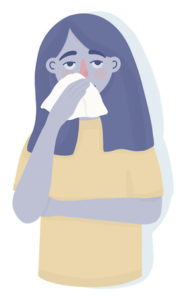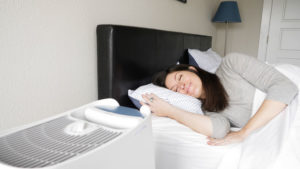Have you ever woken up with a stuffy nose, watery eyes, skin irritation, or felt like your asthma symptoms were exacerbated? It’s possible that your allergies were affected by the presence of dust mites.
What are dust mites and how can you prevent them? We’ll get into all of that and more in this article.
What Are Dust Mites?
Dust mites are microscopic creatures that feed on dead human skin cells. Because of their diet, dust mites like to take residence in common household items like mattresses, pillows, and other bedding products.
Dust mites are the most common household allergen, though you cannot see or feel them, so they are difficult to detect. If you were to equip yourself with the necessary tools that provide 10x magnification, you would see an arthropod creature with a round body and eight legs — similar to the appearance of a small spider.
Are Dust Mites Dangerous?
Some people are allergic to dust mites and have reactions like sneezing, watery eyes, nasal congestion, asthma aggravation, or trouble breathing when they come into contact with dust mites. This is problematic because dust mites are not visible to the human eye, so it can be difficult to detect the cause of your allergies.
If you aren’t allergic to dust mites, these creatures don’t pose any other health dangers. Unlike some insects and bugs, dust mites do not bite humans or burrow into the skin. But if you like to have a clean environment, it’s best to take measures to get rid of and prevent dust mites in your bedroom.
However, if your mattress becomes full of dust mites, you might have to consider mattress disposal.
Am I Allergic to Dust Mites?
 Naturally being allergic to dust mites will make it even more important that you get rid of them and prevent them from returning.
Naturally being allergic to dust mites will make it even more important that you get rid of them and prevent them from returning.
If you have dust mites and are allergic, you may see some of the following symptoms:
- Watery eyes, runny nose, and sneezing
- Sore throat
- Breathing issues and coughing
- Skin issues
- Exacerbated asthma symptoms
You can be diagnosed with an allergy to dust mites by visiting a doctor. Your doctor could recommend an allergy skin test or an allergy blood test to see if you are sensitive to dust mites.
If you are allergic to dust mites, your doctor may recommend a medication like antihistamines, corticosteroids, decongestants, or leukotriene modifiers. You can also use the home remedies discussed above to prevent or get rid of dust mites in your bedroom.
RELATED: Dust Allergies
How to Get Rid of Dust Mites in Mattresses
Now that you know these creatures exist and are probably feasting on the dead skin cells in your mattress this very minute, you’re probably curious how you can get rid of them. Keep reading for a few simple steps you can take today.
1. Wash Your Bedding in Hot Water
Dust mites will not survive if you wash them in high temperatures. One study found that washing your bedding items at least 140 degree Fahrenheit can be enough to completely eliminate all dust mites in your bedding.
This should be a regular part of your routine to keep your bedding clean. It’s usually recommended that you wash your bedding weekly. It may help to have an extra bedding set to swap out every time you wash your bedding.
Fun fact: Extremely cold temperatures can also eliminate dust mites. You can try sticking smaller items like a stuffed animal or small pillow in the freezer for a couple hours.
RELATED: How to Wash a Comforter
2. Dispose of Old Bedding
We recommend you swap out your mattress every 7-10 years simply because mattresses lose support over time, but it’s also important to think about your hygiene and when it’s time to get new bedding products.
Sheets, pillows, duvets, comforters, toppers, and blankets, all have a limited lifespan.
RELATED: Is Buying Allergy-Proof Bedding Worth It?
3. Lower the Humidity In Your Bedroom
Dust mites are attracted to dark, humid areas. Dust mites also require a certain level of humidity to live, so if you bring an air purifier or dehumidifier into your bedroom, that could be a huge help.
While there may be some drawbacks to having to run a dehumidifier, and it won’t be the end-all-be-all solution for eliminating dust mites, it can be a good method to keep dust mites out for extended periods of time.
See More: Best Hypoallergenic Mattresses
4. Vacuum Your Mattress
A vacuum cleaner can be an effective tool for sucking dust mites out of your mattress. Not every vacuum cleaner will be as easy to handle and maneuver in a way that you can easily vacuum your mattress. You may want to consider a handheld vacuum cleaner for cleaning your mattress.
Also be sure if you have carpets that you’re regularly vacuuming those as well, since dust mites also like to make a home in soft carpet.
5. Call a Professional
If worst comes to worst, you may want to call in a professional to help you deep clean your home to get rid of dust mites. Check with pest control companies near you to see if they can get rid of dust mites. Alternatively, you may want to hire a professional cleaner.
How to Prevent Dust Mites in Mattresses
Now that you know how to get rid of dust mites in your mattress that have been accumulating for some time, let’s take a look at a few important steps to keep in your cleaning routine to prevent dust mites in the future.
- Don’t make your bed – this recommendation is not mom-approved! A study published that making your bed actually keeps in moisture, making a better environment for dust mites. If you don’t make the bed, the mattress can dry out more easily, and reduce the number of dust mites that live there.
- Use a metal or wood bed frame – dust mites cannot live in wood or metal, so you should choose this type of frame.
- Wash sheets and bedding with hot water regularly – dust mites cannot survive a wash with hot water, but they may survive a cold-water wash.
- Avoid stuffed animals on the bed – stuffed animals are prime time for dust mites, especially if they’re being dragged around with a baby or toddler. Keep these away from your mattress.
- Clean your mattress regularly – few people even think to clean a mattress, especially if it looks clean, but it’s important to regularly clean it to get rid of as many dust mites as possible. At least a few times a year.
- Get a dust mite cover – plastic covers will make certain that someone’s mattress is not infested.
- Use dust mite sprays – There are many different dust mite sprays available that you can spray over your bedding products. These won’t be enough to completely eliminate the problem, but they can help. You can also make your own spray using household items like vinegar and baking soda.
Final Thoughts
Don’t freak out. The idea that these little guys are infesting one’s mattress is a terrible thought for most, but know that they are very common.
You can follow the above advice to prevent dust mites from living in your mattress, but don’t lose sleep over it. If you want to learn about how individual mattress brands fare when it comes to dust mites (and many other characteristics), read our mattress reviews.
Also, it might be time to replace your mattress if you can’t get it clean.



